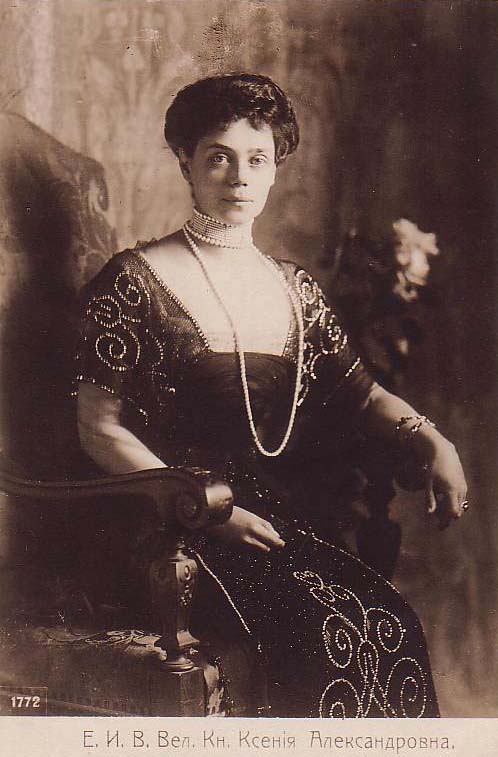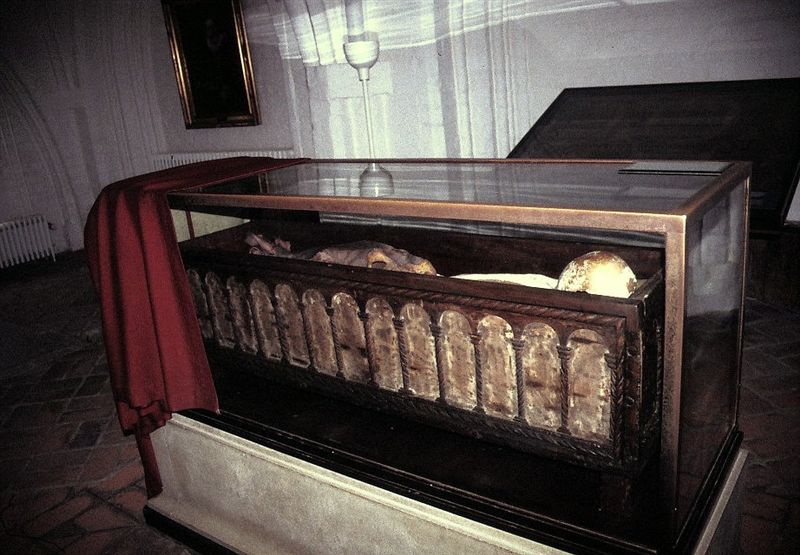© Unofficial Royalty 2025

Queen Elizabeth II of the United Kingdom; Credit – Wikipedia
April 21, 1509 – Death of King Henry VII of England at Richmond Palace in Richmond, Surrey, England; buried at Westminster Abbey in London, England
King Henry VII was the son of Edmund Tudor, 1st Earl of Richmond, who died three months before his son’s birth, leaving a 13-year-old pregnant widow, Lady Margaret Beaufort. Henry’s father, Edmund Tudor, was the eldest child of Owen Tudor and Catherine of Valois, widow of King Henry V of England. His mother, Lady Margaret Beaufort, was the only child of John Beaufort, 1st Duke of Somerset and Margaret Beauchamp of Bletso. Lady Margaret was a descendant of King Edward III of England through her father. At the time of Henry’s birth, the Wars of the Roses, the fight for the English throne between the House of Lancaster and the House of York, was two years old. His mother was a descendant of the House of Lancaster. In 1470, after the Lancastrian King Henry VI was murdered in the Tower of London, Henry’s uncle, Jasper Tudor, left England for France and took his nephew Henry with him to keep him safe. In 1485, Henry Tudor sailed to Wales with a small French and Scottish force. He then marched towards England accompanied by his uncle Jasper Tudor and John de Vere, 13th Earl of Oxford. On August 22, 1485, at the Battle of Bosworth Field, the last significant battle of the Wars of the Roses, the last king of the House of York and the Plantagenet dynasty, King Richard III of England, lost his life and his crown. The battle was a decisive victory for the House of Lancaster, whose leader, 28-year-old Henry Tudor, Earl of Richmond, became the first monarch of the House of Tudor. In 1486, King Henry VII married Elizabeth of York, King Edward IV’s eldest child, uniting the House of York and the House of Lancaster. Henry and Elizabeth had seven children, including King Henry VIII of England. Through their daughter Margaret Tudor, they are the ancestors of the British royal family and many other European royal families.
Unofficial Royalty: King Henry VII of England
April 21, 1673 – Birth of Wilhelmine Amalie of Brunswick-Lüneburg, Holy Roman Empress, wife of Joseph I, Holy Roman Emperor, in Hanover, then in the Duchy of Brunswick-Lüneburg, now in the German state of Lower Saxony
When the future Holy Roman Emperor Joseph I began having affairs at the age of 15, his mother thought the pious Roman Catholic Wilhelmine Amalie, who was five years older than Joseph, would have a positive influence on Joseph, and he would then stop having affairs. The couple married in 1699, and had three children, but their only son died from hydrocephalus before his first birthday. Joseph did not stop his affairs, and the affairs combined with the death of his only son took a toll on his marriage. In 1705, Joseph succeeded his father in the Habsburg hereditary lands and was elected Holy Roman Emperor. Six years later, Joseph died from smallpox. In 1722, after both her daughters had married, Wilhelmine Amalie retired to the convent she had founded for the Salesian nuns, the Monastery of the Visitation of Mary in Vienna, where she died eleven days before her sixty-ninth birthday.
Unofficial Royalty: Wilhelmine Amalie of Brunswick-Lüneburg, Holy Roman Empress
April 21, 1767 – Birth of Elisabeth of Württemberg, Archduchess of Austria, first wife of the future Emperor Franz I of Austria, in Treptow an der Rega in Brandenburg-Pomerania, now Trzebiatów, Poland
Full name: Elisabeth Wilhelmine Luise
When she was fifteen years old, Elisabeth went to Vienna, Austria to prepare to become the bride of Archduke Franz, the nephew of Holy Roman Emperor, Joseph II. The Protestant princess was educated by nuns at the Church and Monastery of the Visitation and converted to Roman Catholicism. Elisabeth married Archduke Franz (the future emperor) in 1788, but died two years later in childbirth after giving birth to a daughter who lived only four months.
Unofficial Royalty: Elisabeth of Württemberg, Archduchess of Austria
April 21, 1815 – Birth of Louise Rasmussen, Countess Danner, former mistress and morganatic third wife of King Frederik VII of Denmark, in Copenhagen, Denmark
Louise, a dancer with the Danish Royal Ballet, became acquainted with the son of King Christian VIII, Crown Prince Frederik of Denmark, who had already divorced two wives. Louise and Frederik had a relationship during the 1840s. In 1848, Frederik’s father died and he succeeded to the Danish throne as King Frederik VII. Upon becoming king, Frederik wished to marry Louise but the government was not in favor of the marriage. In 1849, King Frederik VII signed a new constitution, changing the monarchy from an absolute monarchy to a constitutional monarchy. The signing of the new constitution made Frederik so popular that the government granted him permission to morganatically marry Louise Rasmussen. Louise was not queen consort and was officially styled as Countess Danner. The marriage appears to have been a happy one but had much opposition and Louise was treated poorly in social circles. Frederik and Louise did not have any children. Frederik died in 1863 and Louise survived him by eleven years, dying in Genoa, Italy on March 6, 1874, at the age of 58. While King Frederik VII was buried at Roskilde Cathedral, the traditional burial place of the Danish Royal Family, Louise was not accorded a resting place near her husband. She was buried in a burial mound in the castle garden of her home Jægerspris Castle.
Unofficial Royalty: Louise Rasmussen, Countess Danner
April 21, 1829 – Birth of Anne Sutherland-Leveson-Gower, Duchess of Sutherland, Queen Victoria’s Mistress of the Robes 1870–1874
Born Anne Hay-Mackenzie, the only child of John Hay-Mackenzie of Newhall and Cromarty, she married George Sutherland-Leveson-Gower, 3rd Duke of Sutherland. In 1870, she succeeded her sister-in-law, Elizabeth Campbell, Duchess of Argyll, as Mistress of the Robes, and served until 1874. The position had also previously been held by her mother-in-law Harriet Sutherland-Leveson-Gower, Duchess of Sutherland four different times between 1837 and 1861.
Unofficial Royalty: Anne Sutherland-Leveson-Gower, Duchess of Sutherland
April 21, 1843 – Death of Prince Augustus, Duke of Sussex, son of King George III of the United Kingdom, at Kensington Palace in London, England; buried at Kensal Green Cemetery in London, England
Prince Augustus, Duke of Sussex is infamously known for making two marriages in contravention of the Royal Marriages Act 1772. In 1793, a very pregnant Miss Augusta Murray and Mr. Augustus Frederick (the Duke of Sussex). Augusta gave birth to a son a month later. King George III was greatly angered by the marriage, and it was declared null and void in August 1794. Despite this, Augustus and Augusta continued to live together. Another child, a daughter was born in 1801. The two children, deemed illegitimate, used the last name D’Este as both their parents were descendants of the House of Este. After the death of Augusta in 1830, Augustus married again in contravention of the Royal Marriages Act, to a widow, Lady Cecilia Buggin. Because marriage was not considered legal, Cecilia could not take the style and title Her Royal Highness The Duchess of Sussex, so instead, she assumed the surname Underwood, her mother’s maiden name, and was known as Lady Cecilia Underwood. The couple lived at Augustus’ apartments in Kensington Palace. Despite all of this, Augustus was respected by his niece Queen Victoria. He was given the honor of giving her away at her wedding. As a token of her gratitude, Queen Victoria created Augustus’ wife Cecilia Duchess of Inverness in her own right in 1840. On April 21, 1843, Augustus died from erysipelas at the age of 70. Because Augustus feared that his second morganatic wife would not be allowed to be buried in the Royal Vault at St. George’s Chapel, Windsor, he left instructions that he be buried at Kensal Green Cemetery in Kensal Green, London, England, where his wife was later buried.
Unofficial Royalty: Prince Augustus, Duke of Sussex
April 21, 1865 – Birth of Archduke Otto Franz of Austria, father of Karl I, the last Emperor of Austria, in Graz, Austrian Empire, now in Austria
Otto Franz of Austria was the father of Karl I, the last Emperor of Austria, and the brother of the ill-fated Archduke Franz Ferdinand of Austria, whose assassination in 1914 was one of the causes of World War I. Otto Franz married Princess Maria Josepha of Saxony, and the couple had two sons. By 1900, it was clear that Otto Franz had contracted syphilis, and he withdrew from public life. He was in agonizing pain for the last two years of his life and was forced to replace his nose with a rubber prosthetic due to the facial deformity caused by syphilis. On November 1, 1906, Archduke Otto Franz, aged forty-one, died.
Unofficial Royalty: Archduke Otto Franz of Austria
April 21, 1892 – Death of Alexandrine of Prussia, Grand Duchess of Mecklenburg-Schwerin, wife of Grand Duke Paul Friedrich of Mecklenburg-Schwerin, in Schwerin, Grand Duchy of Mecklenburg-Schwerin, now in Mecklenburg-Vorpommern, Germany; buried at Schwerin Cathedral
In 1822, Alexandrine married the future Grand Duke Paul Friedrich of Mecklenburg-Schwerin, and they had three children. Her husband became Grand Duke of Mecklenburg-Schwerin in 1837. He died five years later and was succeeded by the couple’s son Friedrich Franz II. At the time of her death, Alexandrine had been widowed for fifty years, lived through the reign of her son, and saw her grandson succeed to the Grand Ducal throne of Mecklenburg-Schwerin. She was also the last living grandchild of King Friedrich Wilhelm II of Prussia and had seen the Prussian throne held by her father, two brothers, a nephew, and a great-nephew.
Unofficial Royalty: Alexandrine of Prussia, Grand Duchess of Mecklenburg-Schwerin
April 21, 1918 – Death of Friedrich II, Duke of Anhalt at Ballenstedt Castle in the Duchy of Anhalt, now in Saxony-Anhalt, Germany; initially buried in the Ducal Mausoleum in Dessau, Duchy of Anhalt, now in Saxony-Anhalt, Germany; in 1958, under Communist East Germany, all remains of members of the House of Anhalt were reburied in the Ziebigker Cemetery in Dessau in a common grave; in 2019, Friedrich’s remains were reinterred in the Marienkirche in Dessau, the traditional burial site of the Dukes of Anhalt-Dessau
In 1889, Friedrich married Princess Marie of Baden, but the couple had no children. Friedrich became the reigning Duke of Anhalt upon his father’s death in January 1904. He established a Court Theatre, which would become very well-known throughout Europe, and attracted some of the leading singers and musicians from around the world. Friedrich died on April 21, 1918, aged 61. In 1958, the remains of members of the House of Anhalt were removed from the Ducal Mausoleum secretly by night for political reasons. Dessau was then in Communist East Germany. All the remains were reburied in the Ziebigker Cemetery in Dessau in a common grave, marked only by a simple wooden cross. In 2019, Friedrich’s remains were moved a second time and reinterred in the Marienkirche in Dessau, the traditional burial site of the Dukes of Anhalt-Dessau dating back to the 15th century. The Marienkirche was destroyed during World War II and has since been rebuilt.
Unofficial Royalty: Friedrich II, Duke of Anhalt
April 21, 1926 – Birth of Queen Elizabeth II of the United Kingdom at 17 Bruton Street in London, England
Full name: Elizabeth Alexandra Mary
Destined to become the longest-reigning British monarch, Princess Elizabeth Alexandra Mary of York was born at 2:40 am on April 21, 1926, at 17 Bruton Street in Mayfair, London, the home of her maternal grandparents. She was the daughter of the future King George VI and Lady Elizabeth Bowes-Lyon (at the time, the Duke and Duchess of York), and was named in honor of her mother, her great-grandmother, Queen Alexandra, and her grandmother, Queen Mary. Her paternal grandparents were King George V and Princess Victoria Mary of Teck, and her maternal grandparents were Claude Bowes-Lyon, 14th and 1st Earl of Strathmore and Kinghorne, and Cecilia Cavendish-Bentinck. At the time of her birth, Elizabeth was third in the line of succession to the British throne, following her uncle, The Prince of Wales (later King Edward VIII and Duke of Windsor), and her father. She succeeded to the throne when her father died on February 6, 1952. In 2022, Queen Elizabeth II celebrated her Platinum Jubilee, marking seventy years on the throne. Queen Elizabeth II died at 96 at Balmoral Castle, her home in Balmoral, Scotland, on September 8, 2022. She is the longest-reigning British monarch, surpassing her great-great-grandmother Queen Victoria on September 9, 2015. Queen Elizabeth II reigned for 25,782 days or 70 years, 214 days. Only King Louis XIV of France (reigned May 14, 1643 to September 1, 1715, for 26,407 days or 72 years, 110 days) has reigned longer. (Note: Lengths of reign are from a list of monarchs of states that were internationally sovereign for most or all of their reigns and have verifiable reigns by an exact date.)
Unofficial Royalty: Queen Elizabeth II of the United Kingdom
April 21, 1992 – Death of Grand Duke Vladimir Kirillovich of Russia, son of Grand Duke Kirill Vladimirovich of Russia and Princess Victoria Melita of Edinburgh and Saxe-Coburg and Gotha, in Miami, Florida; buried in the Grand Ducal Mausoleum at the Peter and Paul Fortress in St. Petersburg, Russia, the first Romanov to be buried in Russia since the Russian Revolution
Grand Duke Vladimir Kirillovich of Russia was the pretender to the throne of Russia from 1938 to 1992.
Unofficial Royalty: Grand Duke Vladimir Kirillovich of Russia
April 21, 2007 – Birth of Princess Isabella of Denmark, daughter of King Frederik X of Denmark, at the Rigshospitalet, in Copenhagen, Denmark
Full name: Isabella Henrietta Ingrid Margrethe
Denmark changed its succession law in 2008 to absolute primogeniture, where the succession passes to the eldest child of the sovereign regardless of gender. Males and females have equal succession rights. This means that King Frederik X’s second-born child Isabella is second in the line of succession to the Danish throne after her elder brother Christian, and is ahead of her younger brother Vincent.
Unofficial Royalty: Princess Isabella of Denmark
This article is the intellectual property of Unofficial Royalty and is NOT TO BE COPIED, EDITED, OR POSTED IN ANY FORM ON ANOTHER WEBSITE under any circumstances. It is permissible to use a link that directs to Unofficial Royalty.










